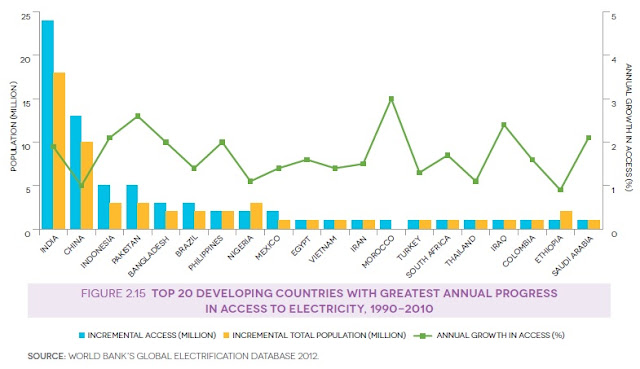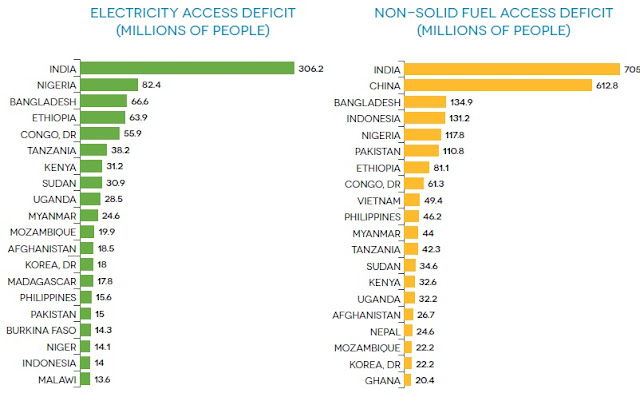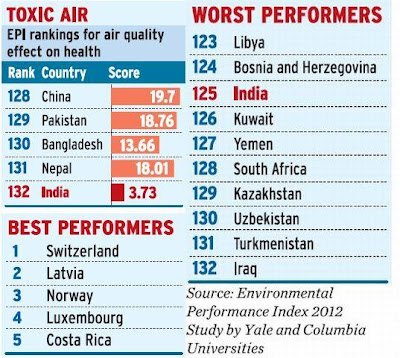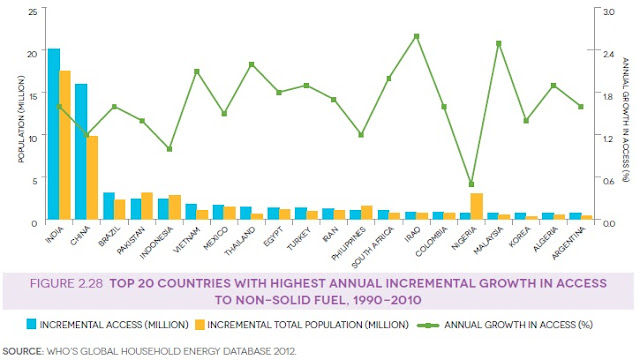PakAlumni Worldwide: The Global Social Network
The Global Social Network
Pakistan Energy Supply Fails to Keep Pace With Growing Access
Pakistan has made remarkable progress in electrification of its towns and villages both in absolute terms and as percentage of population over the past two decades, according to a recently-released report titled "Global Tracking Framework" issued jointly by the World Bank and the International Energy Agency. This report at least partly explains the dramatic increase in demand-supply gap and consequent increase in load-shedding in Pakistan.
The report says that 60 percent of Pakistanis had access to electricity in 1990, 80 percent in 2000 and 91 percent in 2010. By 2010, 88 percent people of rural and 98 percent of the country's urban population had access to electricity. Comparable figures in India are as follows: 51% in 1990, 62% 2000, and 75% in 2010. 93% of urban and 67% of rural Indians had access to electricity in 2010.
The report identifies top 20 countries with the largest number of people to have gained access to electricity over the past 20 years. Of these, 12 are in Asia. They brought electrical service to 1.3 billion people (of the 1.7 billion electrified globally between 1990 and 2010), 283 million more than their population increase. The most impressive expansion of electrification occurred in India, China, Indonesia, Pakistan and Bangladesh. The advances in these populous countries are of enormous significance for achievement of the global universal access target.
The detailed World Bank report identified India as the most deprived country in terms of access to energy: as many as 306.2 million of its people are still without this basic utility. The remaining 19 nations lacking access to energy, with the number of deprived people is as follows: Nigeria (82.4 million), Bangladesh (66.4 million), Ethiopia (63.9 million), Congo (55.9 million), Tanzania (38.2 million), Kenya (31.2 million), Sudan (30.9 million), Uganda (28.5 million), Myanmar (24.6 million), Mozambique (19.9 million), Afghanistan (18.5 million), North Korea (18 million), Madagascar (17.8 million), the Philippines (15.6 million), Pakistan (15 million), Burkina Faso (14.3 million), Niger (14.1 million), Indonesia (14 million) and Malawi 13.6 million).
In addition to access to electricity, the report also details access to non-solid fuels like oil and natural gas (fuels other than firewood, dung or charcoal commonly used in poor countries for cooking) as a key parameter of progress in terms of energy. Such access helps reduce environmental pollution and associated human health hazards.
The goal of universal access to modern energy depends critically on the efforts of 20 high-impact countries which include Bangladesh, China, India and Pakistan. Together, these 20 countries account for more than two thirds of the population currently living without electricity (0.9 billion people) and more than four-fifths of the global population without access to non-solid fuels (2.4 billion people). In terms of electricity, India has by far the largest access deficit; exceeding 300 million people, while for non-solid cooking fuel, India and China each have access deficits exceeding 600 million people.
This tracking report is part of UN's Sustainable Energy For All (SE4ALL) Initiative launched in 2012. The initiative recognizes the importance of universal access to modern energy as a key part of empowering the poor and lifting large numbers of people out of poverty and deprivation.
For the newly-connected rural poor in Pakistan, even a couple of hours of electricity a day is better than no electricity all. Even a brief period of service enables them to charge up their cell phones and watch a little bit of television to stay informed and connected.These small things significantly improve the quality of life of those who lived without any electrical connections in the last decade or two. Eventually one hopes that the energy crisis will be resolved to bring supply and demand in better balance.
Related Links:
Haq's Musings
Pakistan Leads South Asia in Clean Energy
India's Air Most Toxic in the World
World Bank Data on Energy Use Per Capita
Pakistan Needs Shale Gas Revolution
US Census Bureau's International Stats
Pakistan's Vast Shale Gas Reserves
US AID Overview of Pakistan's Power Sector
US Can Help Pakistan Overcome Energy Crisis
Abundant and Cheap Coal Electricity
US Dept of Energy Report on Shale Gas
Pakistan's Twin Energy Crises
Pakistan's Electricity Crisis
Pakistan's Gas Pipeline and Distribution Network
Pakistan's Energy Statistics
US Department of Energy Data
-
Comment by Riaz Haq on June 11, 2013 at 8:54am
-
Here's an OilPrice report on Pak determination to import Iran gas:
Pakistan says it can't let geopolitical concerns interfere with its quest to find ways to keep the lights on. A planning minister said last weekend that all options must be on the table to resolve ongoing energy woes and that could include actually moving on a long-discussed natural gas pipeline from Iran. A rival project from Turkmenistan has U.S. and Asian Development Bank support, though with U.S. priorities shifting, the new Pakistani government may have greater freedom in terms of its regional social circles.
The U.S. government last week tightened the screws on the Iranian energy sector on the heels of a damning report from the International Atomic Energy Agency. U.S. sanctions are meant to starve Iran of the revenue it could use to finance its controversial nuclear program and, to some extent, the U.S. efforts are working better than ever.
Nawaz Sharif is in the dawn of his third stint as prime minister of Pakistan. His third non-consecutive term marks the first time that a civilian government ended a full five-year term and handed power over to another administration by a democratic vote. Last week, he told members of Parliament the day of U.S. drone strikes over Pakistani territory are over.
"We respect the sovereignty of other countries, but others should also respect our sovereignty," he said.
U.S. President Barack Obama told the National Defense University last month that patience should drive foreign policy as it relates to developing democracies like Pakistan's. With Sharif's administration in power, and the war in Afghanistan winding down, it's time to shift U.S. focus to new and emerging threats. The core of al-Qaida is on the path to defeat, the president said, and operations like the raid that killed Osama bin Laden in 2011 can no longer be the norm. That means that no longer can U.S. policy drive the terms of a democratic Pakistan. When a U.S. drone strike left at least nine people dead in Pakistan last week, it was Sharif's government calling the shots by issuing a formal complaint against the attack.
Pakistani Federal Minister for Planning Ahsan Iqbal said the government needs to ensure natural gas supplies from wherever they come from. The top priority for Sharif's administration isn't making friends, but keeping the lights on, he said. Pakistan's national security is compounded by domestic frustration with an energy crisis that leaves most of the country without power for much of the day. With temperatures hovering in the triple digits Fahrenheit, foreign alliances may be the least of his concerns if there's no electricity soon.
The United States is turning its attention elsewhere, meaning Sharif can conduct business without too much worry of immediate U.S. repercussions. Without cash to pay the bills, Pakistan's energy production operates at about 50 percent capacity during the hot summer months. Iran, however, said it would help finance the construction of a natural gas pipeline from the South Pars field in the Persian Gulf, one of the largest in the world.
Sharif's administration said energy was at the top of its 100-day agenda. The federal planning minister said that agenda includes the Iranian pipeline, once dubbed the Peace Pipeline, U.S. foreign policy concerns be damned.
"We will continue the work at the gas pipeline because such a vital project cannot be set aside in hard times like the present," he said.
http://oilprice.com/Energy/Natural-Gas/Damn-the-Sanctions-and-Bring...
-
Comment by Riaz Haq on June 11, 2013 at 8:22pm
-
Here's a link to good overview of Pak economic indicators from Economic Survey of Pakistan 2012-13:
http://www.finance.gov.pk/survey/chapters_13/Economic%20Indicators.pdf
-
Comment by Riaz Haq on June 11, 2013 at 10:33pm
-
Here are excerpts of an ET report on load shedding:
Not only does there seem to be no early end in sight to the power crisis, but Pakistan’s energy woes will also be a huge drag on economic growth, reveals the Pakistan Economic Survey 2012-13 launched here on Tuesday.
“The critical issue is that, according to National Transmission and Despatch Company (NTDC), the annual electricity demand growth rate is forecasted to hover around 5 to 6 per cent over the next ten years. With the current position of [power generation] expansion, it seems that the crisis will not [soon] be over, which in turn will affect economic growth,” the survey revealed.
As of March 2013, the number of consumers has increased to 21.704 million, although the consumption pattern has remained more or less the same in 2012-13, with domestic consumers standing at 43 per cent, industrial consumers at 26 per cent and agricultural consumers at about 11 per cent.
--------
The survey stated that Pakistan’s power sector is heavily dependent on gas supplies, and the reduction of this supply, due to misallocation and low growth, has crippled its performance.
There was negative growth in the consumption of gas during Jul-March 2012-13. The analysis of the sectoral consumption indicates that during July-March 2012-13, the highest share in gas consumption remained in the power sector (27.5 %) followed by industry (22.6 %).
As the government accorded a priority to providing gas to households, the share of households in gas consumption remained 23.2 per cent. However, the trend of providing gas to the power sector is declining since 2005-06 except in 2012, where there was a growth of 6 per cent. Transport is the other significant sector that posted a positive growth in gas consumption of 5.3 per cent during 2011-12, however, during July-March 2012-13 a negative growth of 16 per cent has been witnessed in this sector.
At 16 per cent, the share of the fertilizer industry still remains significant but there was negative growth of 7 per cent in 2012, as compared to the previous year.
Increased gas demand and investment on the cards
It is expected that gas will be supplied to approximately 39,000 new consumers and about 350 new towns/villages will be connected to the gas network during the fiscal year 2013-14. Gas utility companies have planned to invest Rs17437 million on transmission projects, Rs27,265 million on distribution projects and Rs11,165 million on other projects, bringing the total investment of Rs. 55,867 million during the fiscal year 2013-14....http://tribune.com.pk/story/562116/pakistan-economic-survey-power-c...
-
Comment by Riaz Haq on July 22, 2013 at 10:25am
-
To enhance access to non-solid fuels like gas, Pak televangelist Aamir Liaqat Husain's foundation has launched “Choolah Ghar” this year, where those deprived and unfortunate people are being facilitated with Free Gas, who does not have Gas facility. Except this, the Mehmooda Sultana Foundation, named after Aamir Liaquat's mother, is supplying food packs to poor people in different hospitals on daily basis.
-
Comment by Riaz Haq on August 20, 2013 at 5:12pm
-
It is estimated that more than half of India's 1.2 billion population do not have access to electricity, despite its recent economic boom.
This affects the rural economy, health and even safety - especially for women.
But now, private companies and NGOs say that they are trying to fill the gap.
Sanjoy Majumder reports.
-
Comment by Riaz Haq on May 18, 2019 at 6:50pm
-
Gas shortage to increase by 157pc next fiscal year
Khaleeq Kiani Updated April 27, 2019
https://www.dawn.com/news/1478633
Gas shortage to increase by 157pc next fiscal year
Khaleeq Kiani Updated April 27, 2019 Facebook Count
With an addition of 700,000 consumers last year, Pakistan’s gas shortfall is estimated to jump by 157 per cent to 3.7 billion cubic feet per day (bcfd) in fiscal year 2019-20 — almost equal to total gas supplies at present.
The estimates have been made by the Oil and Gas Regulatory Authority (Ogra) that put the gas shortfall increasing almost continuously every year to 6.6bcfd by FY2028.
In its flagship “State of the Industry Report 2017-18”, the authority noted that the (natural gas) demand-supply gap during FY2017-18 was 1,447mmcfd and that this gap was expected to rise to 3,720mmcfd by FY2019-20. The regulator put the total gas demand at about 6.9bcfd in fiscal year 2019-20 compared to total supplies of about 3.2bcfd.
It said the demand would increase to 7.7bcfd by 2024 but domestic supplies would fall substantially to 2.3bcfd, leaving a shortfall at 5.5bcfd. The shortfall would practically be about 3.6bcfd in FY2024 as the gap would be partially met by about 1.9bcfd of imported LNG.
The domestic gas production would continue to decline from about 3.3bcfd at present to less than1.6bcfd by 2028 while the gas demand would keep going up to reach 8.3bcfd by that year. Ogra estimated that despite the induction of all the import options, including LNG, Turkmenistan-Afghanistan-Pakistan-India (TAPI) and Iran-Pakistan (IP) pipelines, the total supplies would decline to 3.7bcfd by 2028, creating a net shortfall of about 4.6bcfd, more than total supplies at present.
The regulator said the gap was rising because of higher consumption in almost all the major sectors particularly power, domestic, fertiliser, captive power and industry as the supplies were not keeping pace with higher demand.
Both the gas utility companies added around 0.7 million domestic, commercial and industrial consumers, in their respective systems, during fiscal year 2017-18. Consumer addition is increasing the gap between demand and supplies, day by day. Especially in winter, the gas demand further increased and as a result the government is being forced to curtail supplies to various sectors.
Despite this, the natural gas is a major contributing fuel in the country’s energy mix. Its share in the primary energy mix is around 48pc.
There is a significant rise in demand and consumption of gas by residential and domestic consumers owing to price differential vis-a-vis other competing fuels, i.e. liquefied petroleum gas (LPG), fire wood and coal. The LPG presently accounts for about 1.3pc of the total primary energy supply in the country.
The current size of LPG market is around 1.3 million tonnes per year. The LPG consumption has increased by 5.88pc in 2017-18 compared to the previous year.
LPG consumption during FY2017-18, stood at around 3,508 tons per day. Local production catered for around 58pc, the rest was imported.
The share of re-gasified LNG in the overall gas supply increased to 23pc in FY 2017-18. The total gas consumers were more than 9.2m by the end of FY2017-18, including 6.3m in the SNGPL network and 2.9m in the SSGCL network.
The power sector was the main consumer of natural gas during FY 2017-18, consuming 37pc, followed by domestic sector 20pc, fertiliser 17pc, captive power 10pc, industrial sector 9pc, transport 5pc, and commercial sector having 2pc share.
Punjab had the highest 50pc consumption, followed by Sindh 39pc, Khyber Pakhtunkhwa 9pc and Balochistan 2pc. Natural gas supplies during the year stood at 4.357bcfd, of which Sindh supplied 50pc, whereas Khyber Pakhtunkhwa, Balochistan and Punjab supplied 12, 11 and 4pc respectively. The remaining 23pc of gas was imported in the form LNG.
Comment
Twitter Feed
Live Traffic Feed
Sponsored Links
South Asia Investor Review
Investor Information Blog
Haq's Musings
Riaz Haq's Current Affairs Blog
Please Bookmark This Page!
Blog Posts
Pakistan Household Survey HIES 2024-25 Raises More Questions Than It Answers
Recently released HIES 2024-25 household integrated economic survey by Pakistan Bureau of Statistics (PBS) raises more questions than it answers. For example, it shows that Pakistani households are buying lower amounts of basic food ingredients like wheat, meat and eggs in the last four years, implying that people are eating less to cover other expenses, like electricity and gas. But it doesn't explain why the households have reported significantly lower purchases of these items than…
ContinuePosted by Riaz Haq on January 6, 2026 at 5:00pm
Happy New Year 2026: Pakistan's Year 2025 in Review
As we enter the year 2026, it is time to review the year 2025 and wish you all Happy New Year 2026! May it bring peace, prosperity and happiness to all!!
The year 2025 saw Pakistan defeat a brazen Indian attack on its soil, while reviving its economy and…
ContinuePosted by Riaz Haq on December 30, 2025 at 9:30pm — 7 Comments
© 2026 Created by Riaz Haq.
Powered by
![]()






You need to be a member of PakAlumni Worldwide: The Global Social Network to add comments!
Join PakAlumni Worldwide: The Global Social Network